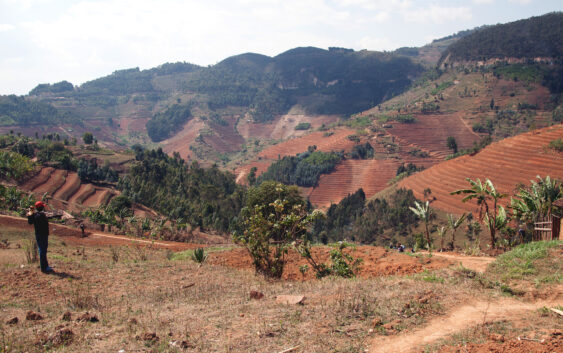RWANDA, DRC & BURUNDI US$25M INITIATIVE CLIMATE CRISIS

Rwanda, the Democratic Republic of Congo (DRC), and Burundi are set to benefit from a regional initiative dubbed “Transforming Agri-Food Systems in West and Central Africa (TAFS-WCA)” which is aimed to increase food security and combating the climate crisis.
The US$25 million initiative has been launched by CGIAR, a global research partnership for a food secure future dedicated to reducing poverty, enhancing food and nutrition security, and fighting climate change.
The initiative aims to improve nutrition and food security within the context of climate change in West and Central Africa through nutritious, climate-adapted, and market-driven food systems.
West and Central Africa are one of the six regional intervention areas.
Patrick Karangwa, The Director-General of Rwanda Agricultural and Animal Resources Development Board said that the Initiative will contribute to enhancing food, land, and water systems, resulting in improved nutrition, livelihoods, and environmental sustainability in the region.
“The initiative is expected to help the continent realize agriculture’s potential to transform food, land, and water systems in a climate crisis.
We work with the centers in Rwanda on a range of research for development initiatives including crop productivity, animal resources development, and institutional strengthening among others.” he said.
We are thrilled to engage more with the upcoming initiatives to further strengthen the contribution to the national agricultural research system and strategic partnerships that will make innovative research for development much easier and more effective, he noted.
The partnership, he said, involves scaling out knowledge, technologies, and innovations generated from over 50 years of research.
“The initiative specifically aims at transforming nutritious, climate-adapted, and market-driven food systems. It will do so through the development and scaling of novel and inclusive production and postharvest technologies, participatory decision-making, and planning, informed governance, and the strengthening of gender and youth business hubs,” Karangwa added.
Jan Helsen, the initiative lead, said that the 13 research centers in the CGIAR network have been implementing various projects that aim at ensuring food security through research and partnerships with national research centers.
He said seven CGIAR research institutes work independently in the agricultural research portfolio within the various countries in the Central African region.
The centers include the International Institute of Tropical Agriculture (IITA), International Food Policy Research Institute (IFPRI), Africa Rice, International Water Management Institute (IWMI), World Fish Center, the Alliance of Bioversity International, The International Center for Tropical Agriculture (CIAT), and The International Potato Center (CIP).
However, Helsen said: “From now on, we will be working together as one team, therefore harmonizing all our engagements within regional and national agricultural systems.”
Regina Kapinga, the initiative co-lead added that as centers that have been engaging broadly in research-for-development activities, this coming together will pave the way for greater collaboration and integrated contribution toward food and nutrition security across countries.
“This initiative will build on the legacy and lessons learned from a long-run multi-partner initiative that has been implemented in DRC, Burundi, and Rwanda, called “Consortium for Improving Agriculture-based Livelihoods in Central Africa (CIALCA),” she said.
The initiative will work on participatory research on effective scaling to ensure past investments in the region can be institutionalized and strengthened, mainly on the crop productivity and income pathway.
Why the initiative is timely
Agriculture contributes between 30 percent and 50 percent of West and Central Africa’s GDP and provides income and livelihoods to between 70 percent and 80 percent of the region’s population.
But the sector, agricultural experts have said, has not been able to live up to its potential to feed the region’s growing population, due to the disruptive forces of climate change, including rapid land degradation and increasing incidences of invasive pests and diseases.
As a result, they said, consumers often resort to imported and ultra-processed foods, increasing the triple burden of malnutrition.
“Reduced biodiversity is affecting soil health and crop reproduction, while degraded landscapes are no longer One Health-sensitive. Markets and value chains are at best fragmented due to huge post-harvest losses, dilapidated infrastructure, and a non-supportive policy environment.
The capacity of youth and women to participate in the transformation of food systems remains low, while increasing conflicts often result in poor governance, further curtailing any potential in the region,” they said.
The initiative activities include sustainable seed and management systems, informed digital agriculture for climate resilience —managing climate risks and accessing services, scaling land and water innovations for resilient agri-food systems, Youth and women entrepreneurship models in food value chains as well as accelerating impact investments.
A glance at expected outcomes
In three years at least 80,000 smallholder households will have access to climate-resilient, nutrient-dense crop varieties; with at least 16,000 of them using five climates resilient, nutrient-dense crop varieties and six good agricultural practices.
An increase of at least 30 percent in household dietary diversity scores will be attained.
Three million farmers, 30 value chain actors, and three governments will be using timely climate information and early warning systems for improved decision-making.
The governments will use inclusive approaches toward landscape management, and 100 rural communities will have developed informed and inclusive land and water management plans that will diversify income from agriculture and increase production, creating jobs and stability.
At least 20,000 youth and 15,000 women will be engaged in value-added activities related to agriculture, and at least 50 percent of these will have access to credit.
An increase of at least 20 percent in the women empowerment in agriculture index will be attained.
At least 10 key partners in the next phase implementation plans ($25 million investment) are consistently using three validated scaling tools.
Access to quality, nutrient-dense seed, and climate-smart agricultural practices, as well as reduced post-harvest losses, will contribute to food and nutrition, and health security as a result.
SOURCE: NewTimes

